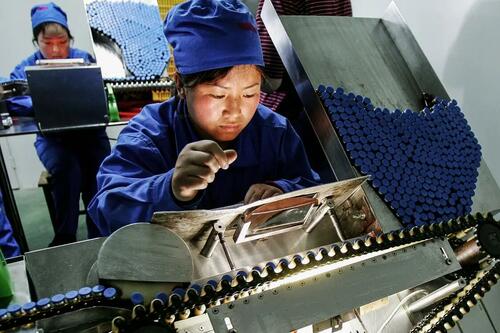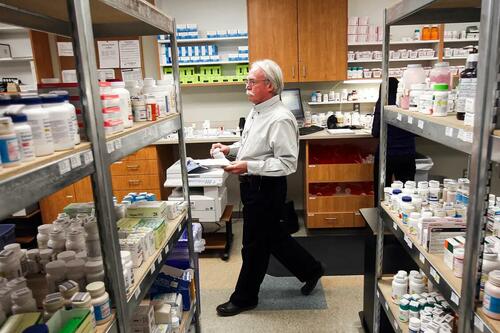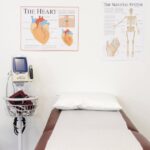
Authored by Autumn Spredemann via The Epoch Times (emphasis ours),
The ongoing scarcity of critical medications has trapped Americans between a rock and a hard place.

Active national drug shortages hit a 10-year high this year, leaving many health care providers, pharmacies, and hospitals without enough life-saving and supportive medications, according to data collected by the University of Utah Drug Information Service.
A survey by the same university in July found that 99 percent of the 1,123 pharmacists who responded—many of whom work in hospitals—reported shortages. One-third of the pharmacists listed the shortages as "critically impactful," which is defined as being forced to ration medication or delay or even cancel medical treatments.
The U.S. Food and Drug Administration lists 124 medications in short supply as of Dec. 21; the list topped out at 309 earlier this year.
The shortage applies to multiple categories, including antibiotics—both amoxicillin and azithromycin are on the list—and staple analgesics such as ketamine, as well as nitroglycerin injections, a vital tool in helping to control congestive heart failure in heart attack patients.
Securing medication is also a challenge for those managing chronic illnesses.
Jennifer, a Waterford, Michigan, resident who asked that her last name not be disclosed, told The Epoch Times that she was only recently able to start taking her Type 2 diabetes medication again after being stranded without it for the second time since July 2022.
She started taking Ozempic again on Dec. 10, after being unable to fill her prescription for weeks.
Ozempic is one of the many drugs affected by current shortages; that's reportedly due, in part, to Ozempic's off-label use as a weight-loss supplement. The manufacturer, Novo Nordisk, lists the official reason for the shortage as "increased demand."
"The pharmacist told me it’s on back order and, 'You need to call around to see if other stores or pharmacies have it in stock.' And I’m like, no, that’s your job," Jennifer said.
She was noticeably frustrated—there are physical consequences of having gaps in her medication. In addition to managing her A1C levels, the drug comes with unpleasant side effects for some patients, which take time to wear off.

One of these is extreme lightheadedness, which Jennifer has encountered each time she's restarted taking Ozempic after enduring a usage gap. She said she gets dizzy to the point of feeling like she's about to "pass out" after resuming the medication.
"I haven’t taken it for weeks, and now I’m having a reaction [side effects] since it’s all been flushed out of my system," she said.
Unpleasant side effects aside, Jennifer says she feels like she doesn't have a choice other than to ride out the medication gaps when they happen, because the drug has helped manage her diabetes so well.
But medication scarcity isn't a new problem. U.S. drug shortages have plagued Americans for nearly 20 years.
A 2011 study observed that increasingly frequent drug shortages had been a problem during the past decade. They were attributed to the same hurdles the industry faces today: Challenges in acquiring raw materials, manufacturing and regulatory problems, and supply chain disturbances.
There's also the heavy reliance on other countries to manufacture pharmaceuticals, which some U.S. lawmakers say leaves the country too dependent on foreign drug manufacturing.
"Currently, about 90 percent of drugs dispensed at U.S. pharmacies are generic drugs that overwhelmingly come from communist China and India," Sen. Rick Scott (R-Fla.) said in a September statement upon introducing his American Drugs Act, which would create "a strong incentive for companies to invest in domestic pharmaceutical production."

"Americans can’t trust communist China and can’t allow any reliance on Xi’s evil regime for life-saving medicine," Mr. Scott said.
Currently, the United States leans heavily on other countries to manufacture key starting materials (KSM) and active pharmaceutical ingredients (API), which are the critical building blocks of pharmaceuticals.
As of 2021, China became the world's leading supplier of both KSMs and APIs, according to a report issued by the European Parliament.
In March, a U.S. congressional strategic preparedness committee noted that up to 95 percent of generic sterile injectable drugs used for critical acute care in the United States rely on KSMs from China and India.
Reliance on foreign production of U.S. pharmaceuticals is an issue that former President Donald Trump identified and attempted to address during his term. Alongside the America First Healthcare Plan, President Trump's $354 million deal in 2020 with U.S.-based Phlow Corp. was an effort to increase domestic manufacturing of generic drugs and APIs.
More than three years later, in September, Phlow said it was manufacturing APIs for the "federal government, to be stored in the nation’s first reserve of APIs."
"This will ensure the resiliency and availability of critical medicines in times of geopolitical crises, trade disputes, natural disasters, or future public health emergencies," Eric Edwards, CEO and co-founder of Phlow, said in a statement.
He said the company is also making KSMs and "rebuilding a resilient domestic supply chain."

The Biden administration has also responded to the widespread outcry over drug shortages, prompting a November White House announcement that the Defense Production Act (DPA) will be used to encourage investment in the domestic manufacturing of "essential medicines, medical countermeasures, and critical inputs that have been deemed by the president as essential to the national defense."
The DPA grants a sitting president extensive authority to manage vital economic resources, including the power to expand domestic production.
Read the rest here...
Authored by Autumn Spredemann via The Epoch Times (emphasis ours),
The ongoing scarcity of critical medications has trapped Americans between a rock and a hard place.

Active national drug shortages hit a 10-year high this year, leaving many health care providers, pharmacies, and hospitals without enough life-saving and supportive medications, according to data collected by the University of Utah Drug Information Service.
A survey by the same university in July found that 99 percent of the 1,123 pharmacists who responded—many of whom work in hospitals—reported shortages. One-third of the pharmacists listed the shortages as “critically impactful,” which is defined as being forced to ration medication or delay or even cancel medical treatments.
The U.S. Food and Drug Administration lists 124 medications in short supply as of Dec. 21; the list topped out at 309 earlier this year.
The shortage applies to multiple categories, including antibiotics—both amoxicillin and azithromycin are on the list—and staple analgesics such as ketamine, as well as nitroglycerin injections, a vital tool in helping to control congestive heart failure in heart attack patients.
Securing medication is also a challenge for those managing chronic illnesses.
Jennifer, a Waterford, Michigan, resident who asked that her last name not be disclosed, told The Epoch Times that she was only recently able to start taking her Type 2 diabetes medication again after being stranded without it for the second time since July 2022.
She started taking Ozempic again on Dec. 10, after being unable to fill her prescription for weeks.
Ozempic is one of the many drugs affected by current shortages; that’s reportedly due, in part, to Ozempic’s off-label use as a weight-loss supplement. The manufacturer, Novo Nordisk, lists the official reason for the shortage as “increased demand.”
“The pharmacist told me it’s on back order and, ‘You need to call around to see if other stores or pharmacies have it in stock.’ And I’m like, no, that’s your job,” Jennifer said.
She was noticeably frustrated—there are physical consequences of having gaps in her medication. In addition to managing her A1C levels, the drug comes with unpleasant side effects for some patients, which take time to wear off.

One of these is extreme lightheadedness, which Jennifer has encountered each time she’s restarted taking Ozempic after enduring a usage gap. She said she gets dizzy to the point of feeling like she’s about to “pass out” after resuming the medication.
“I haven’t taken it for weeks, and now I’m having a reaction [side effects] since it’s all been flushed out of my system,” she said.
Unpleasant side effects aside, Jennifer says she feels like she doesn’t have a choice other than to ride out the medication gaps when they happen, because the drug has helped manage her diabetes so well.
But medication scarcity isn’t a new problem. U.S. drug shortages have plagued Americans for nearly 20 years.
A 2011 study observed that increasingly frequent drug shortages had been a problem during the past decade. They were attributed to the same hurdles the industry faces today: Challenges in acquiring raw materials, manufacturing and regulatory problems, and supply chain disturbances.
There’s also the heavy reliance on other countries to manufacture pharmaceuticals, which some U.S. lawmakers say leaves the country too dependent on foreign drug manufacturing.
“Currently, about 90 percent of drugs dispensed at U.S. pharmacies are generic drugs that overwhelmingly come from communist China and India,” Sen. Rick Scott (R-Fla.) said in a September statement upon introducing his American Drugs Act, which would create “a strong incentive for companies to invest in domestic pharmaceutical production.”

“Americans can’t trust communist China and can’t allow any reliance on Xi’s evil regime for life-saving medicine,” Mr. Scott said.
Currently, the United States leans heavily on other countries to manufacture key starting materials (KSM) and active pharmaceutical ingredients (API), which are the critical building blocks of pharmaceuticals.
As of 2021, China became the world’s leading supplier of both KSMs and APIs, according to a report issued by the European Parliament.
In March, a U.S. congressional strategic preparedness committee noted that up to 95 percent of generic sterile injectable drugs used for critical acute care in the United States rely on KSMs from China and India.
Reliance on foreign production of U.S. pharmaceuticals is an issue that former President Donald Trump identified and attempted to address during his term. Alongside the America First Healthcare Plan, President Trump’s $354 million deal in 2020 with U.S.-based Phlow Corp. was an effort to increase domestic manufacturing of generic drugs and APIs.
More than three years later, in September, Phlow said it was manufacturing APIs for the “federal government, to be stored in the nation’s first reserve of APIs.”
“This will ensure the resiliency and availability of critical medicines in times of geopolitical crises, trade disputes, natural disasters, or future public health emergencies,” Eric Edwards, CEO and co-founder of Phlow, said in a statement.
He said the company is also making KSMs and “rebuilding a resilient domestic supply chain.”

The Biden administration has also responded to the widespread outcry over drug shortages, prompting a November White House announcement that the Defense Production Act (DPA) will be used to encourage investment in the domestic manufacturing of “essential medicines, medical countermeasures, and critical inputs that have been deemed by the president as essential to the national defense.”
The DPA grants a sitting president extensive authority to manage vital economic resources, including the power to expand domestic production.
Read the rest here…
Loading…





